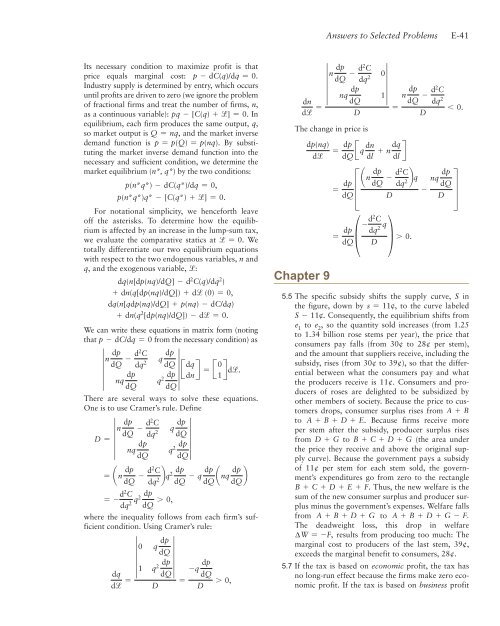Answers to Selected Problems
Answers to Selected Problems
Answers to Selected Problems
Create successful ePaper yourself
Turn your PDF publications into a flip-book with our unique Google optimized e-Paper software.
Its necessary condition <strong>to</strong> maximize profit is that<br />
price equals marginal cost: p - dC(q)/dq = 0.<br />
Industry supply is determined by entry, which occurs<br />
until profits are driven <strong>to</strong> zero (we ignore the problem<br />
of fractional firms and treat the number of firms, n,<br />
as a continuous variable): pq - [C(q) + l] = 0. In<br />
equilibrium, each firm produces the same output, q,<br />
so market output is Q = nq, and the market inverse<br />
demand function is p = p(Q) = p(nq). By substituting<br />
the market inverse demand function in<strong>to</strong> the<br />
necessary and sufficient condition, we determine the<br />
market equilibrium (n*, q*) by the two conditions:<br />
p(n*q*) - dC(q*)/dq = 0,<br />
p(n*q*)q* - [C(q*) + l] = 0.<br />
For notational simplicity, we henceforth leave<br />
off the asterisks. To determine how the equilibrium<br />
is affected by an increase in the lump-sum tax,<br />
we evaluate the comparative statics at l = 0. We<br />
<strong>to</strong>tally differentiate our two equilibrium equations<br />
with respect <strong>to</strong> the two endogenous variables, n and<br />
q, and the exogenous variable, l:<br />
dq(n[dp(nq)/dQ] - d2C(q)/dq2 )<br />
+ dn(q[dp(nq)/dQ]) + dl (0) = 0,<br />
dq(n[qdp(nq)/dQ] + p(nq) - dC/dq)<br />
+ dn(q2 [dp(nq)/dQ]) - dl = 0.<br />
We can write these equations in matrix form (noting<br />
that p - dC/dq = 0 from the necessary condition) as<br />
n<br />
4<br />
dp<br />
dQ - d2C dq2 nq dp<br />
dQ<br />
q dp<br />
dQ<br />
dp<br />
q2 dQ<br />
4 J dq<br />
R = J0<br />
dn 1 Rdl.<br />
There are several ways <strong>to</strong> solve these equations.<br />
One is <strong>to</strong> use Cramer’s rule. Define<br />
n<br />
D = 4<br />
dp<br />
dQ - d2C dq2 nq dp<br />
dQ<br />
q dp<br />
dQ<br />
4<br />
dp<br />
q2 dQ<br />
= ¢n dp<br />
dQ - d2C dp<br />
≤q2<br />
dq2 dQ<br />
= - d2C dp<br />
q2 7 0,<br />
dq2 dQ<br />
dp dp<br />
- q ¢nq<br />
dQ dQ ≤<br />
where the inequality follows from each firm’s sufficient<br />
condition. Using Cramer’s rule:<br />
dq<br />
dl =<br />
0 q<br />
4<br />
dp<br />
dQ<br />
4<br />
dp<br />
2 1 q<br />
dQ<br />
=<br />
D<br />
-q dp<br />
dQ<br />
D<br />
7 0,<br />
dn<br />
dl =<br />
<strong>Answers</strong> <strong>to</strong> <strong>Selected</strong> <strong>Problems</strong><br />
n<br />
4<br />
dp<br />
dQ - d2C dq2 nq dp<br />
dQ<br />
D<br />
The change in price is<br />
dp(nq)<br />
dl<br />
Chapter 9<br />
0<br />
4<br />
1<br />
=<br />
dp dn dq<br />
= Jq + n<br />
dQ dl dl R<br />
= dp<br />
dQ D<br />
¢n dp<br />
dQ - d2C dq<br />
D<br />
= dp<br />
dQ §<br />
- d2C q<br />
2 dq<br />
D<br />
n dp<br />
dQ - d2 C<br />
dq 2<br />
2 ≤q<br />
¥ 7 0.<br />
D<br />
-<br />
E-41<br />
6 0.<br />
nq dp<br />
dQ<br />
D T<br />
5.5 The specific subsidy shifts the supply curve, S in<br />
the figure, down by s = 11., <strong>to</strong> the curve labeled<br />
S - 11.. Consequently, the equilibrium shifts from<br />
e1 <strong>to</strong> e2 , so the quantity sold increases (from 1.25<br />
<strong>to</strong> 1.34 billion rose stems per year), the price that<br />
consumers pay falls (from 30¢ <strong>to</strong> 28¢ per stem),<br />
and the amount that suppliers receive, including the<br />
subsidy, rises (from 30¢ <strong>to</strong> 39¢), so that the differential<br />
between what the consumers pay and what<br />
the producers receive is 11¢. Consumers and producers<br />
of roses are delighted <strong>to</strong> be subsidized by<br />
other members of society. Because the price <strong>to</strong> cus<strong>to</strong>mers<br />
drops, consumer surplus rises from A + B<br />
<strong>to</strong> A + B + D + E. Because firms receive more<br />
per stem after the subsidy, producer surplus rises<br />
from D + G <strong>to</strong> B + C + D + G (the area under<br />
the price they receive and above the original supply<br />
curve). Because the government pays a subsidy<br />
of 11¢ per stem for each stem sold, the government’s<br />
expenditures go from zero <strong>to</strong> the rectangle<br />
B + C + D + E + F. Thus, the new welfare is the<br />
sum of the new consumer surplus and producer surplus<br />
minus the government’s expenses. Welfare falls<br />
from A + B + D + G <strong>to</strong> A + B + D + G - F.<br />
The deadweight loss, this drop in welfare<br />
∆W = -F, results from producing <strong>to</strong>o much: The<br />
marginal cost <strong>to</strong> producers of the last stem, 39¢,<br />
exceeds the marginal benefit <strong>to</strong> consumers, 28¢.<br />
5.7 If the tax is based on economic profit, the tax has<br />
no long-run effect because the firms make zero economic<br />
profit. If the tax is based on business profit
















